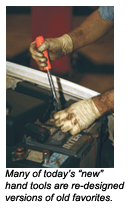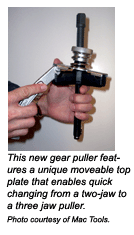There is an old saying that there is nothing new under the sun. A recent trend in the tool industry might lead you to think there is some truth to that statement.
It seems that although a new tool gets introduced every few minutes — with suppliers bringing more and more new items to market faster than ever before — many of these new tools feel familiar to me. When I first noticed this happening a few years ago, I just assumed it was a symptom of being in the industry for so long (or old age setting in!). But in talking with other folks in the business it became apparent pretty quickly that I wasn’t imagining this. The most common comment I heard was “that tool seems so familiar.”
Today’s automotive tool warehouse distributors are presented with hundreds of new items for review every year. Some days it’s a struggle just finding the time to evaluate them all. But in speaking with some WDs, we’ve noticed a trend in the tool business.
 It turns out that none of us are imagining things — manufacturers are going back to their archives for new product ideas more and more. I’ve learned from several large manufacturers that it is quite common for them to review old designs and design patent information for ideas and starting points for developing new tools. Other new product designs and ideas are sent to them by shop owners and technicians like you.
It turns out that none of us are imagining things — manufacturers are going back to their archives for new product ideas more and more. I’ve learned from several large manufacturers that it is quite common for them to review old designs and design patent information for ideas and starting points for developing new tools. Other new product designs and ideas are sent to them by shop owners and technicians like you.
Perhaps the most amazing current-day success story about redesigning an old tool is the new ratcheting wrenches that are available. The original ratcheting wrench design dates back to the early 1900s. Ratcheting wrenches are designed around the basic idea of not having to take the tool off the fastener to re-position. By using a system of cogs and pawls, it is possible to turn the tool in one direction to move the fastener and then move it the other direction to get more “room.”
Today’s tools have to meet new criteria that were not important just a few years ago.
Underhood spaces are tighter than ever before. Obstructed fasteners seem to be the rule now instead of the exception. We all used to joke about having to take the motor out of cars to change the oil. It hasn’t gotten that bad on all cars, but it is getting closer to that all the time.
As working conditions under the hood get tougher, smaller and more complicated, the need for more sophisticated tools is greater than ever. The new ratcheting wrenches are a great example of a manufacturer designing a product to meet the current requirements of today’s automobile designs and the needs of the automotive repair industry.
Another great example of automotive tools being redesigned is the automotive test light. This basic tool has been around for as long as cars have used batteries and had lights. Originally, these tools were literally nothing more than a small bulb with a wire hooked on one side to use for testing current. While the tool has been improved over the years, the basic design didn’t change much for the first 50-plus years since the item was invented.
 The advent of computer technology on today’s vehicles has forced inventors and designers to come up with new versions of the same old idea. One of the early advancements for test lights was to reduce “draw” of the test light below a standard 10 milliamp level to ensure that the tool would not do damage to sensitive computer circuits. This also became critical to avoid accidental deployment of airbag systems. This last issue can be not only an extremely expensive mistake, but also a dangerous one.
The advent of computer technology on today’s vehicles has forced inventors and designers to come up with new versions of the same old idea. One of the early advancements for test lights was to reduce “draw” of the test light below a standard 10 milliamp level to ensure that the tool would not do damage to sensitive computer circuits. This also became critical to avoid accidental deployment of airbag systems. This last issue can be not only an extremely expensive mistake, but also a dangerous one.
The next evolution for the old test light was polarity sensing capability. This allowed the user of these tools to tell if the circuit being tested is “hot” or has a good ground. In order to do that, a manufacturer realized that by powering a test light with its own source of DC power, you gave the tool infinitely more flexibility and it could perform far more complex and conclusive tests. Tools like this have been developed and have saved technicians countless thousands of labor hours by reducing trial-and-error testing to a science.
Speaking of lighting, who would have thought even a few years ago that we would all be so interested in LED lights? Fifteen years ago the only LED lights were used as indicator lights on equipment and electronics. Today, everywhere you look in the automotive industry someone is promoting or talking about work lights, service lights and flash lights with LED technology. This is an area where there have been relatively rapid advances in a short period of time. New manufacturing techniques have allowed suppliers to provide brighter LED light sources for a fraction of the original cost of the first generation of this type of lights. In addition to that, LED lights are cooler and consume very little power, which allows them to run for long periods of time without having to replace batteries or recharge them.
One of my favorite “new” tools is screwdrivers. No matter how long I work in this industry, I will never stop being amazed at how many different ways you can design this simple tool. Screwdrivers are tools that have been around from the beginning of the industrial age. The first screwdrivers had wooden handles with the shaft for the screw. Since I started working in the tool business in the early ’90s, I would guess I have seen the introduction of no less than 20 to 30 “new, innovative, original” designs for screwdriver handles. One of the earliest “big” developments was neon colors for handles. Then came “Ergonomic Design.” Every manufacturer has their own interpretation of what the shape of a handle needs to be to fit well, give maximum torque and last a long time. New materials are constantly being introduced, which just adds to the puzzle as manufacturers continue their search for the holy grail of screwdriver design.
Gear pullers have been around since the early 1930s, if not before. The basic design has remained unchanged, every gear puller ever designed has a yoke, a center screw, and two, three or four jaws or “legs.” The configuration of jaws could change, and the amount of tonnage you could pull varied with the size of the puller, but the overall design has been stable since the tool first came to market. Until this year.
Recently, a U.S. manufacturer introduced a gear puller that could be changed from a two-jaw to a three-jaw puller and back again, in seconds. The new design is impressive. With older gear pullers, if you wanted to change your puller from a two- to three-jaw puller, you would have to unscrew and re-screw bolts as you move the jaws into a new position on the yoke. It’s easy to do, but a little time-consuming. With this new design, the manufacturer has created a moveable top plate that lets you quickly change from a two-jaw internal to a three-jaw external puller. You just have to unscrew the top plate, pop the jaws into place, replace the top plate, and you’re ready to resume work. It’s a nifty improvement to an old tool that truly hadn’t changed in more than 70 years.
There has been an incredible amount of energy, time and money dedicated to an area of the car previously ignored — the tires.
In the last few years there has been a new focus placed on the importance of tire pressure. There are several motivating factors including safety, tire life and, of course, fuel economy. With the cost of fuel soaring past the $3 mark per gallon, consumers are demanding solutions to improve fuel economy. Under-inflated tires are a major contributor to poor fuel economy.
Responding to the need for better control of tire pressures and recent government-mandated regulations regarding tire pressure, manufacturers have developed a new technology to monitor the issue.
Enter TPMS — Tire Pressure Monitoring Systems. These systems are processor-controlled, remote-mounted devices to keep track of the pressure of each individual tire on a vehicle. The sensors communicate with a central processor reporting pressure in the tire.
Seems so simple, right? What could possibly go wrong with a system like that? The sensors have to be able to contend with conflicting electronic signals, temperature extremes, harsh shocks, oh! and for fun they get spun at speeds up to 2,000 rpm!
Two related tools that have been introduced relative to TPMS are again older tools with new applications and designs. Both of these new tools are torque wrenches. It is now necessary to set the tongue value of tire valve stems! Wow! The first time I heard this I was sure it was a joke! Along the same lines there is now a new torque wrench that has been developed to set the torque value on the sensors that bolt to the wheel assembly. These sensors can be damaged by over tightening. When changing a wheel sensor it is critical to use the new torque wrench.
This might be a good point to mention that just because a manufacturer redesigns an old tool or idea that it doesn’t mean it’s not a good one. That’s kind of the point of being a manufacturer and especially an inventor. The number one goal is to build that better mouse trap.
In the movie Field of Dreams, the voice told Kevin Costner: “If you build it, he will come.” It is this kind of passion that drives inventors and manufacturers to develop and introduce new versions of old designs. We all like new designs and the latest technology in the products we own and use. In the tool business, new items absolutely drive the business.
Let’s face it, no matter how much you like your old tools, if you don’t add new tools to the mix, things can get stale.
So I will leave you with this thought; maybe there are new things out there under the sun…just waiting for you to think of and design!

